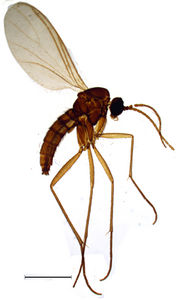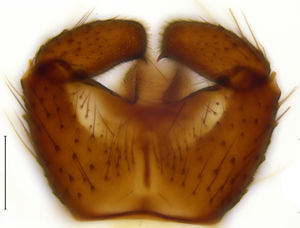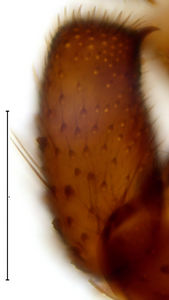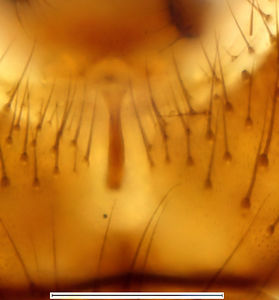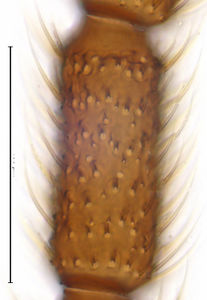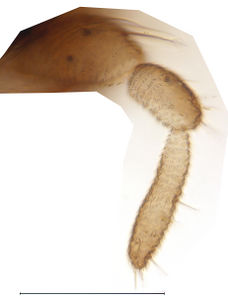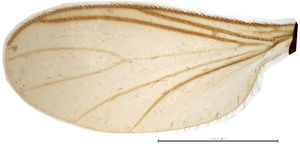Trichosiopsis erinaceus
Ordo: Diptera
Familia: Sciaridae
Genus: Trichosiopsis
Name
Trichosiopsis erinaceus unpublished
Type material
Holotype: ♂, 18.06.2005, sweep netting, leg. Heller, KH4402 in SDEI
Type locality
Germany, Thuringia, Hörselberg-Hainich, Craula
Barcoded material
| Stadium | Country | Province | Locality | Habitat | Method | Date | Collector | Collection Number | Collection | Latitude | Longitude | Elevation (m) |
|---|---|---|---|---|---|---|---|---|---|---|---|---|
| 1 ♂ | Germany | Baden-Württemberg | Malsch, Wolfsgrube | Feuchtbrache | Malaise trap | 31.05.2011 | Dieter Doczkal | DIP03789 | ZSMC | 48.8878 | 8.3483 |
Other material studied
Germany: 16 ♂, Baden-Württemberg, Grenzach-Wyhlen, Otto-Jäggi-Weg, Felsnase, Malaise trap, Doczkal, 24.4.-08.05.2011, PKHH 8627-8633; 7 ♂, Malsch, Heckelbachklamm, Malaise trap, Doczkal, 2.-21.06.2003, PKHH 7721; 3 ♂, Wolfsgrube, Feuchtbrache, Malaise trap, Doczkal, 30.-31.05.2011, PKHH 8085; 5 ♂, Schelingen, Buchenwald, sweep netting, Heller, 28.05.2011, PKHH 7845; 1 ♂, Thuringia, Hainich Nationalpark, Craulaer Kreuz, Buchenwald, sweep netting, Heller, 18.06.2005, PKHH 4398; 2 ♂, Mischwald bei der Thiemsburg, sweep netting, Heller, PKHH 4358 [as Leptosciarella rejecta in Menzel & Heller (2006)[1]: 55]; Denmark: 1 ♂, Sonderhav, alter Buchenwald, sweep netting, Heller, 22.05.2010, PKHH 7590; Sweden: 8 ♂, Skåne, Simrishamn, Skane län, Stenshuvud National Park: Svabeholmsskog, hornbeam forest, Malaise trap, Swedish Malaise Trap Project, 20.-26.06.2005, PKHH 6665/6657.
Description (male)
Head. Eye bridge 4 rows of facets. Antenna unicolour. LW-index of 4th flagellomere 2.2–2.5; neck 0.31–0.42 × segment width; transition of basal part to neck pronounced. Colour of neck unicolour. Antennal setae as long as segment width; of normal strength; adjacent. Palpus darkened; short, or of normal length; palpomeres 3. First palpomere of normal shape, or thickened; with 4–6 setae; with only sparse sensilla. Second palpomere short and oval. Third palpomere longer than first. Thorax. Colour brown. Notum unicolour. Thoracic setae normal; black. Posterior pronotum setose. Postpronotal setae 3–5. Mesothoracic sclerites bare. Legs. Colour brown. Hind coxa of same colour as femora. Setae on front coxa black. Front tibial organ as patch of setae; dark; front tibial organ not bordered. Tibial setae on hind legs normal, shorter than tibial width. Tibial spurs of equal length. Claws untoothed. Wing. Wing slightly darkened; of normal shape. Wing membrane without macrotrichia. Wing venation weak, with faint stM. M-fork of normal shape. R1 ending at or slightly before base of m-fork; posterior veins with macrotrichia; stM mostly with macrotrichia; CuA1 and CuA2 mostly with macrotrichia; bM bare; r-m mostly setose; bM:r-M 0.85–1.1; st-Cu:bM 0.2–0.35; R1:R 1.2–1.6; c:w 0.65–0.75. Halter darkened; of normal length. Abdomen. Abdominal setae strong; on tergites black; on sternites black. Hypopygium concolour with abdomen; LW-index 0.55–0.7. Base of gonocoxites with strong setae; gonocoxites broadly separated; inner margin of gonocoxites typically U-shaped; inner membrane of hypopygium scarcely setose; ventral margin of gonocoxite with short setae. Gonostylus elongate; LW-index 2.1–2.5; Inner margin straight, or concave; apex equally rounded, or nearly rectangular. Apical tooth present; without internal structure; of medium strength; LW-Index 1.8–2.3. Awl-like setae normal; present beneath apical tooth. Megasetae absent. Whiplash-hair absent. Tegmen 0.4–0.65 × longer than broad; rectangular with rounded edges; without special features; central process absent. Length of ejaculatory apodeme/hypopygium 24–32 %; base of ejaculatory apodeme present. Field with aedeagal teeth clearly visible. Measurements. Body size 2.5–3.1 mm. Hind tibia 1.3–1.6 mm. Wing length 2.2–2.8 mm.
Diagnosis
The species is placed in the Trichosiopsis rejecta group and can be distinguished from other, similar species by the combination of the following characters: strong setae at the base of the gonocoxites; strong and black setae at the fore coxae; gonostylus apically rounded and bulged without an apico-dorsal angle; first segment of palpi slightly thickened; posterior pronotum with setae. Although the habitus, coloration and the general structure of the gonostylus are similar to Trichosiopsis finjae, the apically clearly bulged and rounded gonostylus allows a clear distinction. Because of the apically rounded and bulged gonostylus it also resembles Trichosiopsis cerifera, which has a similarly shaped gonostylus but much longer antennae. Shape of gonostylus and body colouration are also similar to Trichosiopsis orientis, a distinctly larger species.
DNA Barcoding
The COI sequence is assigned to BIN BOLD:ACJ1518 (n=1, K2P: 11.48%).
Ecology
The species is mainly found in Central European forests. The Scandinavian records are only from the most Southern part, an indication, that Tr. erinaceus is adapted to temperate climate.
Etymology
lat. erinaceus = hedgehog. The name refers to the rounded, spinose apex of the gonostylus and also to the similarity with the unresolved species Tr. echinata (echinus = sea urchin).
Discussion
The holotype of this species was originally identified as Tr. rejecta[1] and then considered conspecific to Tr. echinata as shown on Species-ID (Fig 3). The other included species (Figs 2, 4, 5) on that same page is now called Trichosiopsis finjae. The DNA barcodes of both species proved to be clearly different. In fact Tr. erinaceus is not a very typical member of the Tr. rejecta complex. The nearest (remote) genetic neighbour is Tr. orientis.
The to date only successfully barcoded specimen from Malsch, was not selected as the holotype, because it is not available at present and possibly lost. However, specimens from the same sample were studied, which clearly belong to Tr. erinaceus. Therefore the above mentioned BIN is confidently associated with this species.
Distribution
Denmark, Germany, Sweden.
Images
|
